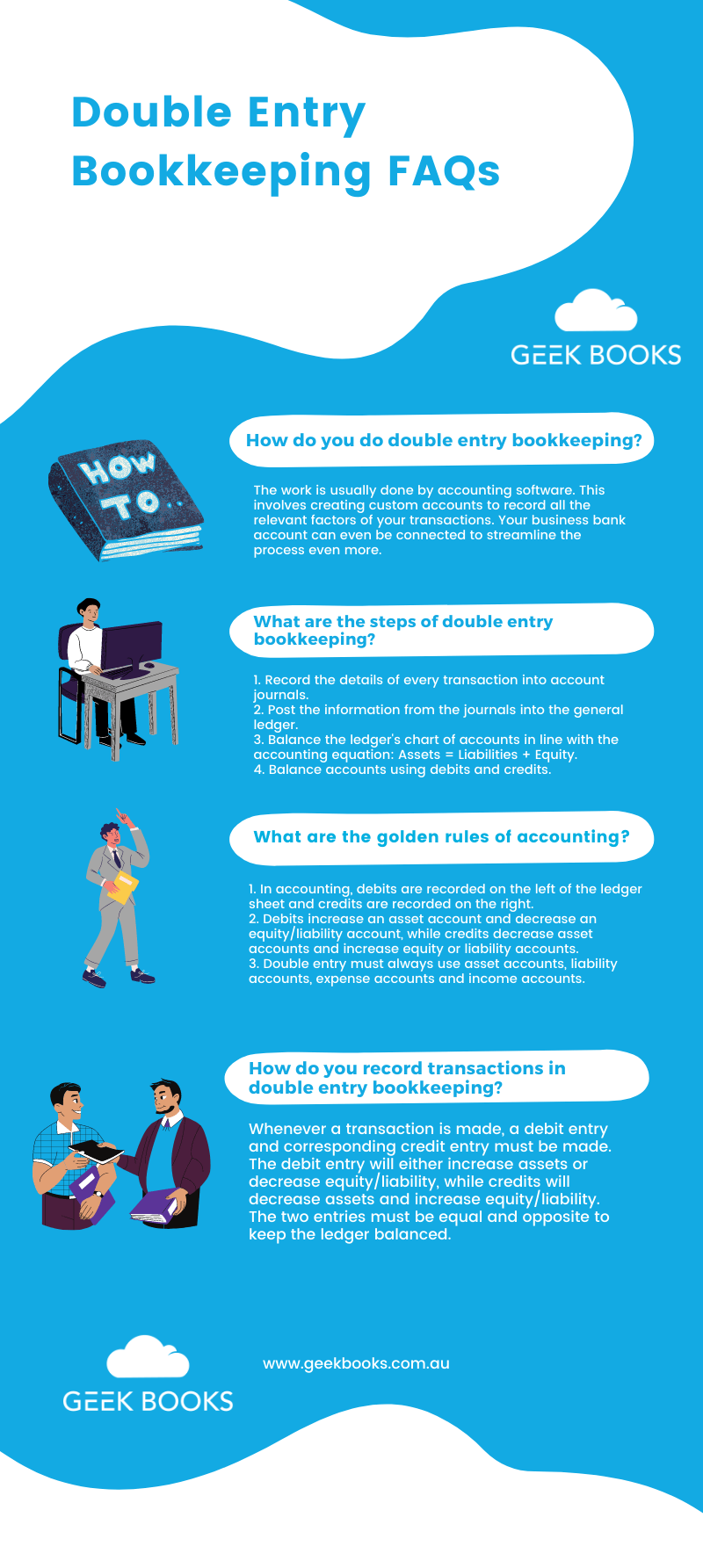If you are familiarising yourself with bookkeeping-related terms, you might ask what exactly is bookkeeping?
Our bookkeeping for beginners guide is a good place to start. But dig a little deeper and another question that may come up is “What is double-entry bookkeeping?’ This is one of those bookkeeping terms that needs a little more explanation.
The short answer is that it is an accounting system for recording transactions that has existed for millennia.
As a core part of the bookkeeper duties checklist, it is the foundation of modern cloud-based bookkeeping, banking and reporting systems.
With double entry bookkeeping, a business can keep track of income and outgoings and gain an understanding of things like profitability and business growth.
You also have a basis for all the reporting and submission obligations a business can have.
Sounds complicated, right?
Well, the principles of double entry bookkeeping are actually quite simple.
Read on to learn how it works and find out just what is double entry bookkeeping used for.
What is Double Entry Bookkeeping?
The governing principle of double entry bookkeeping is that every financial transaction has equal and opposite effects in a minimum of two different accounts.
It works by recording transactions on the basis of credits and debits – when one account gets a debit, a credit is recorded in another.
When you add all the debits together, they must be equal to the sum of all credits – this is the defining standard for modern accounting and it enhances the accuracy of financial statements.
In the accounting world, a debit is an entry added to the left of the account ledger, and a credit lies to the right.
Balance is achieved by keeping the sum of credits and debits for every transaction equal.
The principle satisfies the following accounting equation:
Assets = Liabilities + Equity
On an income statement, the balances in both expense accounts and loss ones are increased by debits and decreased by credits.
With the balances on gains and revenue accounts, it’s the other way round.
Double entry bookkeeping came about in Europe during the mercantile period as a means of rationalising transactions in the commercial world and improving the efficiency of trade.
It also made it easier for bankers and merchants to understand their profits and costs, and may have been a fundamental concept in the creation of capitalism.
Double entry bookkeeping is used to create the balance sheet, which ensures all uses of capital are equal to its sources.
Any company maintaining accurate accounts will record every transaction in a minimum of two accounts.
For example, when a company takes out a bank loan, that borrowed money raises the companies assets, but its loan liabilities also increase by the same amount.
Similarly, if a company purchases raw material with cash, it will add to the inventory asset, but take away from the capital.
Thus, every transaction affects at least two accounts, so recording transactions in this way is called double entry bookkeeping.
Today, double entry bookkeeping is usually done by accounting software.
You could buy this software yourself to maintain your own books, but you would need to spend time familiarising yourself with the way the software works. There are also plenty of free bookkeeping templates out there, but again it can be time-consuming to take this on yourself.
It would also be useful to review our complete bookkeeping guide.
The alternative is to outsource your bookkeeping to skilled, professional bookkeepers like GeekBooks. You may be asking yourself how much does a bookkeeper cost, but bear in mind that you are saving your own time and resources by paying for a specialist service.
Double Entry Bookkeeping Examples
If you still think double entry bookkeeping sounds complicated, you may need to see it in action.
At its most basic, it really is quite a simple system, so let’s take a look at some real-world examples of double entry bookkeeping to help explain the concept:
1. A bakery uses credit to order some new refrigerated delivery trucks for a total price of $250,000.
In accounting for this purchase on credit, the relevant accounting ledgers must be added to.
The business has accumulated new assets, so a debit of $250,000 is added to the asset account.
At the same time, a credit of the $250,000 must be added to the notes payable ledger.
The increase on the asset account and the associated increase in notes payable liability makes it equal.
2. A new takeaway business needs to order a reliable mobile phone for when the driver is out on delivery.
Let’s say the phone costs $1,500 and is paid for in cash.
Once the transaction is complete, a debit entry of $1,500 is added to the asset account, and a corresponding credit entry for the same amount is recorded to assets because of the cash spent.
In the first example written above, you have a scenario where double entry bookkeeping applies to a purchase with credit.
The second one is based on a purchase made with existing capital.
In both cases, you can see how the transaction involves a debit and a credit entry at the same time.
You can find more bookkeeping tips from the experts at GeekBooks here.
In more complex transactions, more than two accounts can be affected, and this is where the work of expert bookkeepers and sophisticated accounting software is extremely valuable.
Why is Double Entry Bookkeeping important?
New businesses that are very small in scale may be able to get by with single entry bookkeeping.
However, there are various advantages of the double entry system that should not be overlooked.
Here are just a few:
- You get a more complete financial picture: double entry bookkeeping is a better way to assess a company’s financial health and growth rate. It is essential when a company has multiple employees, or has to think about things like inventory and debts.
- It helps with financial decision-making: with better insights into profitability and financial strength, business owners can understand their companies better. It pays to see how money has been spent and how it is growing so that you can make better financial decisions.
- Bookkeeping errors are reduced: by creating a balance sheet through double entry bookkeeping, you must always ensure liabilities and equity equal assets. If they don’t, there must be an error in your books. It also helps with transparency, keeping businesses accountable.
- It is favoured by investors and banks: The transparency and comprehensive nature of the double entry system is attractive to investors and banks. The reports it produces provide an accurate, complete picture of how your business is performing financially.
When you take advantage of the GeekBooks month and year end financial reporting services, you will leverage the power of double entry bookkeeping for financial reports that are insightful to business owners and attractive to potential investors.

Double Entry Bookkeeping FAQs
How do you do double-entry bookkeeping?
The work is usually done by accounting software.
This involves creating custom accounts to record all the relevant factors of your transactions.
Your business bank account can even be connected to streamline the process even more.
What are the steps for double-entry bookkeeping?
1. Record the details of every transaction in account journals.
2. Post the information from the journals into the general ledger.
3. Balance the ledger’s chart of accounts in line with the accounting equation: Assets = Liabilities + Equity.
4. Balance accounts using debits and credits.
If any of the terms used above are unfamiliar, you need to educate yourself on common bookkeeping terms.
As previously stated, the double-entry process is usually done with accounting software. GeekBooks can help you get setup and trained in this software if you wish to do your bookkeeping yourself.
What are the golden rules of accounting?
1. In accounting, debits are recorded on the left of the ledger sheet and credits are recorded on the right.
2. Debits increase an asset account and decrease an equity/liability account, while credits decrease asset accounts and increase equity or liability accounts.
3. Double entry must always use asset accounts, liability accounts, expense accounts and income accounts. Every transaction will affect at least two of these accounts, and more accounts may be necessary.
How do you record transactions in double entry bookkeeping?
Whenever a transaction is made, a debit entry and corresponding credit entry must be made.
The debit entry will either increase assets or decrease equity/liability, while credits will decrease assets and increase equity/liability.
The two entries must be equal and opposite to keep the ledger balanced.
Summary
So what is double entry bookkeeping?
It is an approach to bookkeeping where two or more account entries are made for every single transaction.
It’s all about providing a true picture of how every transaction affects your business, and it is a method that has existed for thousands of years.
Despite its age, it is still the accepted standard for modern bookkeeping and, with the possible exception of the very smallest, all businesses should be doing it.
Bookkeeping and accounting are fundamentally different.
Bookkeeping is all about accuracy and getting a clear picture of a company’s financial health, and double entry bookkeeping is the best way to achieve this.
We hope this article has explained double entry bookkeeping for you.
If you would like to learn more about how GeekBooks uses double entry bookkeeping in our services, please feel free to give us a call.
We will be happy to talk you through it and discuss how we could assist you with your business bookkeeping needs.


